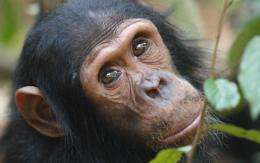Chimps use touches and noisy gestures when trying to get another chimps attention, researcher finds

(Phys.org)—A team led by USC Dornsife Ph.D. student Maureen McCarthy found evidence that chimpanzees are aware of the attention and responsiveness of the chimp they're communicating with, modifying their method of communication to suit.
The research adds to a growing body of work exploring how socially aware chimps are and is continually eroding old notions about what separates humans from their evolutionary cousins.
The chimps McCarthy studied rarely used visual gestures toward other chimps who weren't paying attention to them, instead using touches or noisy gestures to get their attention. In addition, if they were able to use a single gesture to communicate effectively with another chimp, they often stopped there—not bothering to gesture further.
"I was interested in whether they flexibly shifted the types of gestures they used, especially when they failed to get a response initially," McCarthy said. "I found that during play, they used gestures flexibly in order to get a response from another chimp and also to help regulate and continue play."
Her study, co-authored by Mary Lee Abshire Jensvold and Deborah Fouts of the Chimpanzee and Human Communication Institute at Central Washington University, was published online in Animal Cognition in December.
McCarthy is currently studying chimps in Uganda. Readers can follow her blog on the Scientific American website at blogs.scientificamerican.com/expeditions/ and at dornsife.usc.edu/panoramic-perspectives/
Though previous studies have also explored whether great apes can use gestures flexibly based on the audience's attention and response, McCarthy's work was the first to do so with apes who can already communicate using sign language.
"Our study was the first to examine the use of gesture sequences in this unique captive chimpanzee group," she said. "It was also one of just a handful of studies to examine how captive chimpanzees communicate with each other, compared to their human caregivers. This was important because it allowed us to study natural interactions among the chimpanzees."
Studies into ape communication explore the boundaries of their self-awareness and have chipped away at traditional notions of what makes humans different from—or superior to—other animals.
For example, chimps' use of visual communication when addressing individuals who are looking directly at them has been taken as evidence that they recognize that other individuals have a perspective that is different from their own—the "theory of mind" that is considered a must-have in order to be self-aware.
Studies of gesture sequences, such as those by McCarthy, have gained popularity in recent years as scientists seek to understand the full extent of language capability among apes. Among the many questions that remain to be answered is whether apes can flexibly string gestures together to make new meanings the way humans string words together to form new and different sentences.
"My current research at USC focuses on chimpanzees in fragmented forests of Uganda. Whether in the forests of Uganda or in a sanctuary in the U.S., chimpanzees demonstrate remarkable similarities with humans," she explained. "Their complex patterns of communication are just one example. These skills underscore the importance of conserving this endangered species before it is too late."
Journal information: Animal Cognition
Provided by University of Southern California















